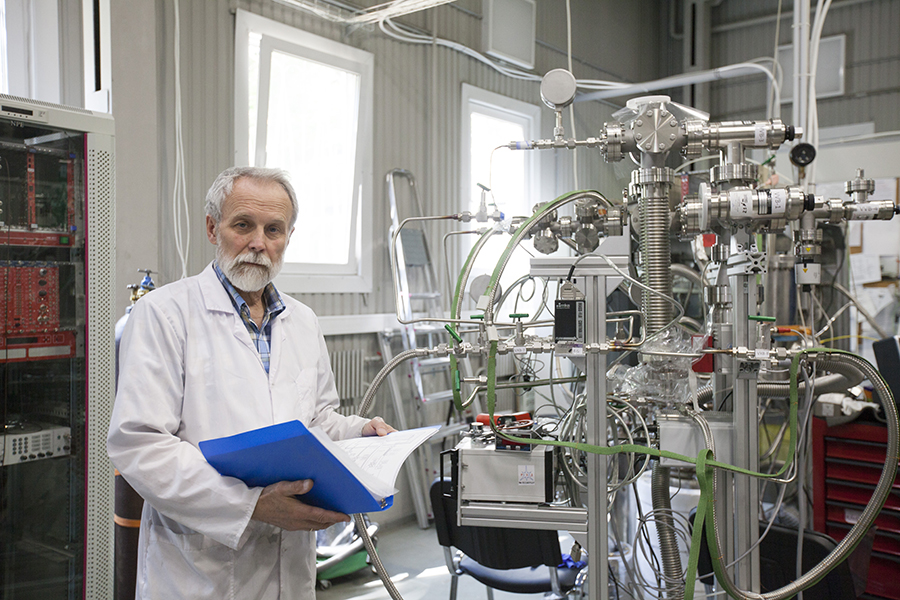The Science journal has published an article which reported about the discovery of an effect of coherent elastic neutrino-nucleus scattering, theoretically predicted 43 years ago. The experiment was carried out by the COHERENT scientific collaboration, composed of 80 physicists from 19 institutes and universities of four countries. In this experiment the Russian Federation is represented by the physics of the Experimental nuclear physics laboratory at the National Research Nuclear University “MEPhI” and the Institute of theoretical and experimental physics at NRC “Kurchatov Institute”.
Coherent elastic neutrino-nucleus scattering plays an important role in the evolution of the Universe. It's a quantum effect which shows itself the most when the wavelength of the neutrino is comparable with the size of the atomic nucleus. Therefore, the experiment is conducted with neutrino of relatively low energies (a few tens of MeV) in the detector-target with the large size of the nucleus (high atomic number). The probability of effect is proportional to the square of the number of neutrons in the nucleus. The price you have to pay for a relatively high probability of such a process is extremely small energy of recoil nucleus, that is a very weak signal.
To conduct an experiment to detect this effect, Russian physicists specially designed and built a unique ultra-sensitive neutrino detector of a new generation RED-100 with 200 kg of liquid xenon as a working medium. The original plan of the experiment involved the combination of the best "neutrino catcher" (RED-100) with the best "neutrino provider" (an accelerator facility Spallation Neutron Source at the Oak Ridge national laboratory, USA). However, due to circumstances beyond scientists control RED-100 did not go to USA and they used more simple detector to register neutrinos which however led to the observation of the effect.

What is now? Will the most advanced neutrino detector in Russia be idle? The head of the Experimental nuclear physics laboratory of MEPhI, Professor Alexander Bolozdynya explains: “We originally planned to experiment with RED-100 in the neutrino flux from a power reactor at the Kalinin nuclear power plant. However, communication with our colleagues from the COHERENT collaboration resulted in intention to use SNS because an experiment with a pulsed source of neutrinos in more convenient for the initial observation of the effect. But now, when existence of the effect has been proved, there is a task of much more detailed study of the effect in the net flux of electron antineutrinos from a nuclear reactor. In addition, there is a prospect of an important practical application of such detectors, which requires further special study”.
Why have Russian physics from MEPhI changed their intention to see the first collision of nuclei with neutrinos at the reactor of the Kalinin nuclear power plant? Is it due to the neutrino flux at the SNS? No, the neutrino flux at the reactor of the Kalinin nuclear power plant is much more powerful. However, the American facility allowed easier separation of the signal from the background because its neutrino flux is of a pulsed nature. This can be compared to searching for a building on the street of an unfamiliar city: at the first glance all the buildings are identical, and you don’t have the exact address. But you know the time in which you will reach the desired object, which greatly facilitates the task of finding the right building.
Having all the advantages as a source of neutrinos, SNS has a significant drawback: three different types of neutrinos (muon neutrinos, antineutrinos and electron neutrinos) are born there, and it is very difficult to understand which of them participates in the studied interaction. A nuclear reactor has another situation – it produces neutrinos of only one type (electron antineutrinos), and the SNS have almost none of them. The task of the near future is clear: to put a super-sensitive neutrino detector RED-100 into a stream of neutrinos from the power reactor at the Kalinin nuclear power plant and to understand what types of interactions are typical for this type of neutrino.
In addition to purely scientific interest, there are other interesting possibilities to apply detectors of this type.
“With the help of detectors of the RED-100 type it is possible to independently control the contents of plutonium-239 in the reactor core, not getting into a nuclear reactor. Let us suppose that Russian government agreed to build a nuclear power plant in another country. In addition to the reactor, we supply them with fuel and take the spent back. The party operating the nuclear power plant is obliged not to touch nuclear fuel. Up to the present moment we had no choice, but to trust the other side on the floor. Now we can imagine that using the neutrino detector of the RED-100 type we can remotely monitor the status of the reactor core and to monitor the content of accumulated plutonium-239 in spent fuel, which is very good for making nuclear weapons. Thus, we will support international efforts to promote nonproliferation of nuclear weapons,” said Alexander Bolozdynya. “If there is unauthorized removal of plutonium-239, it will be inevitably discovered by a detector. IAEA representatives are very interested in our development and expect the continuation of works in this direction.”





